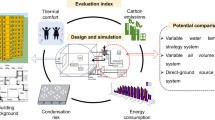Abstract
A building model with radiant cooling system was established and the cooling load, indoor temperature, surface temperature of the walls and other parameters in non-cooling and radiant cooling room were calculated by TRNSYS. The comparative analysis of the characteristics of attenuation and delay proves that the operation of radiant cooling system increases the degree of temperature attenuation of the room and reduces the inner surface temperature of the wall significantly, but has little effect on the attenuation coefficient and delay time of wall heat transfer. The simulation results also show that the inner surface temperature of the walls in the radiant cooling room is much lower than that in non-cooling room in the day with the maximum cooling load, which reduces the indoor operation temperature largely, and improves the thermal comfort. Finally, according to the analysis of indoor temperature of the rooms with different operation schedules of cooling system, it can be derived that the indoor mean temperature changes with the working time of radiant cooling system, and the operation schedule can be adjusted in practice according to the actual indoor temperature to achieve the integration of energy efficiency and thermal comfort.
Similar content being viewed by others
References
SATTARI S, FARHANIEH B. A parametric study on radiant floor heating system performance [J]. Renewable Energy, 2006, 31: 1617–1626.
WEITZMARM P, KRAGH J, ROOTS P. Modeling floor heating systems using a validated two-dimensional ground-coupled numerical model [J]. Building and Environment, 2005, 40: 153–163.
ASHFAQUE A C, RASUL M G., KHAN M M K. Thermal-comfort analysis and simulation for various low-energy cooling technologies applied to an office building in a subtropical climate [J]. Applied Energy, 2008, 85(6): 449–462.
FEUSTEL H E, CORINA S. Hydronic radiant cooling preliminary assessment [J]. Energy and Buildings, 1995, 22: 193–205.
OLESEN B W. Possibilities and limitations of radiant floor cooling [J]. ASHRAE Transaction, 1997, 103(1): 42–48.
OLESEN B W. Control of slab heating and cooling systems studied by dynamic computer simulations [J]. ASHRAE Transactions, 2002, 108(2): 698–707.
LEHMANN B, DORER V, KOSCHENZ M. Application range of thermally activated building systems tabs [J]. Energy and Building, 2007, 39(5): 593–598.
RIJKSEN D O, WISSE C J, van SCHIJNDEL A W M. Reducing peak requirements for cooling by using thermally activated building systems [J]. Energy and Buildings, 2010, 42(3): 298–304.
GWERDER M, TÖDTLI J, HMANN B. Control of thermally active buildings systems [C]// Proceedings of 9th REHVA World Congress for Building Technologies-CLIMA. Helsinki, Finland, 2007: 221–233.
SOURBRON M, BAELMANS M, HELSEN L. Thermal response of thermally activated building systems (TABS) in office buildings [C]// Proceedings of EFFSTOCK. Stockholm, Sweden, 2009: 57–64.
SOURBRON M, HELSEN L. Thermally activated building systems in office buildings: Impact of control strategy on energy performance and thermal comfort [C]// Proceedings of International Conference on System Simulation in Buildings. Liege, Belgium, 2010: 531–542.
GWERDER M, TODTLI J, LEHMANN B. Control of thermally activated building systems (TABS) in intermittent operation with pulse width modulation [J]. Apply Energy, 2009, 86(9): 1606–1616.
WANG Zi-jie. Low-temperature radiant heating and radiant cooling [M]. Beijing: Machinery Industry Press, 2001: 43–44. (in Chinese)
LIU Kui-xing, TIAN Zhe, ZHANG Cheng, WANG Wei-liang. Establishment and validation of modified star-type RC-network model for concrete core cooling slab [J]. Energy and Building, 2011, 43(9): 2378–2384.
LING Ji-hong, ZHANG Yu-feng, TU Guang-bei, WANG Rong-guang. Operation regulation of low temperature water floor panel heating system [J]. HV & AC, 2003, 33(1): 67–72. (in Chinese)
Solar Energy Laboratory. TRNSYS 16, a transient system simulation program [M]. Wisconsin, USA: University of Wisconsin, 2005: 99–100.
LIU Kui-xing. Dynamic simulation and performance analysis for cooling and heating load of terminal [D]. Tianjin: Tianjin University, 2009. (in Chinese)
ZHAO Yong-yi, FAN Cun-yang, XUE Dian-hua, QIAN Yi-ming. Air conditioning [M]. Beijing: China Building Industry Press, 2008: 44–45. (in Chinese)
ZHU Ying-xin, YAN Qi-sen. Building environment [M]. Beijing: China Building Industry Press, 2008: 63–64. (in Chinese)
Author information
Authors and Affiliations
Corresponding author
Additional information
Foundation item: Project(2010DFA72740) supported by the International Science & Technology Cooperation Program of China
Rights and permissions
About this article
Cite this article
Xin, Yj., Wang, Zq. & Tian, Z. Effect of thermal storage performance of concrete radiant cooling room on indoor temperature. J. Cent. South Univ. Technol. 19, 709–714 (2012). https://doi.org/10.1007/s11771-012-1061-y
Received:
Accepted:
Published:
Issue Date:
DOI: https://doi.org/10.1007/s11771-012-1061-y




